
Erythronium, the fawn lily, trout lily, dog's-tooth violet or adder's tongue, is a genus of Eurasian and North American plants in the lily family, most closely related to tulips. The name Erythronium derives from Ancient Greek ἐρυθρός (eruthrós) "red" in Greek, referring to the red flowers of E. dens-canis. Of all the established species, most live in North America; only six species are found in Europe and Asia.

Filipendula ulmaria, commonly known as meadowsweet or mead wort, is a perennial herbaceous plant in the family Rosaceae that grows in damp meadows. It is native throughout most of Europe and Western Asia. It has been introduced and naturalised in North America.
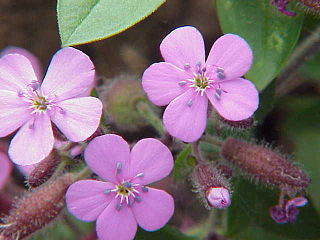
Saponaria is a genus of flowering plants in the family Caryophyllaceae, native to Asia and Europe, and are commonly known as soapworts. They are herbaceous perennials and annuals, some with woody bases. The flowers are abundant, five-petalled and usually in shades of pink or white. The genus is closely related to the genus Silene, being distinguished from these by having only two styles in the flower. It is also related to Gypsophila, but its calyx is cylindrical rather than bell-shaped.
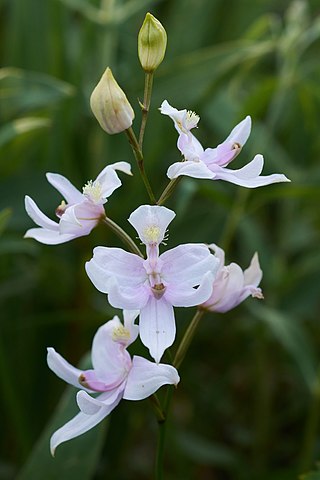
Calopogon oklahomensis, commonly known as the Oklahoma grass pink or prairie grass pink, is a terrestrial species of orchid native to the United States. It is restricted to the states of Alabama, Arkansas, Georgia, Illinois, Indiana, Iowa, Kansas, Louisiana, Minnesota, Mississippi, Missouri, Oklahoma, South Carolina, Tennessee, Texas, and Wisconsin. It is extirpated throughout most of its range. Calopogon oklahomensis is a perennial herb with flowers that are white, pink or purple, with a labellum with an apical region of yellow hairs. Flowers bloom March to July. Its habitats include coastal prairies, savannas, edges of bogs, and oak woodlands. It was described by Douglas H. Goldman in 1995.
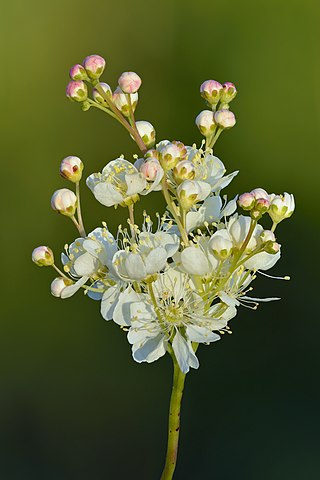
Filipendula vulgaris, commonly known as dropwort or fern-leaf dropwort, is a perennial herbaceous plant in the family Rosaceae, closely related to meadowsweet. It is found in dry pastures across much of Europe and central and northern Asia, mostly on lime.

Actaea pachypoda, the white baneberry or doll's-eyes, is a species of flowering plant in the genus Actaea, of the family Ranunculaceae.

Thalictrum thalictroides, the rue-anemone or windflower, is a herbaceous perennial plant native to woodland in eastern North America. It has white or pink flowers surrounded by a whorl of leaflets, and it blooms in spring.

Thladiantha dubia, the Manchu tubergourd, goldencreeper, wild potato, or (French) thladianthe douteuse, is a herbaceous perennial climbing vine of the gourd family. It is native to Russia, northern China, and Korea, but has been introduced to Japan, southeast Europe, the Galapagos Islands, and scattered locations in North America. It is occasionally grown as a medicinal plant, or as an ornamental in North America.

Heliopsis is a genus of herbaceous flowering plants in the family Asteraceae, native to dry prairies in North and South America. The sunflower-like composite flowerheads are usually yellow, up to 8 cm (3 in) in diameter, and are borne in summer. Species are commonly called ox-eye or oxeye.

Liatris pycnostachya, the prairie blazing star, cattail gayfeather or cattail blazing star, is a perennial plant in the Asteraceae family that is native to the tallgrass prairies of the central United States.

Filipendula rubra, also known as queen-of-the-prairie, is a species of flowering plant in the family Rosaceae native to the northeastern and central United States and southeastern Canada. It prefers full sun or partial shade and moist soil, but tolerates drier soil in a shadier location. It grows tall and firm, and produces blooms that are tiny and pink above its ferny, pointy leaves.
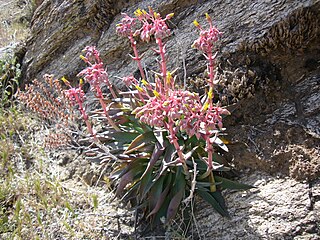
Dudleya saxosa is a perennial succulent plant species in the family Crassulaceae, within the genus Dudleya, which are commonly known as liveforevers. This species is a complex of 3 subspecies of plants, isolated and disjunct in distribution from one another, each with varying levels of ploidy and morphology. One plant is native throughout the deserts and mountains of Southern California, another is found in the Panamint Mountains, and one is found throughout central Arizona.

Erigeron strigosus is a species of flowering plant in the family Asteraceae known by the common names prairie fleabane, common eastern fleabane, and daisy fleabane.
Meadowsweet may refer to:

Canadanthus is a North American monotypic genus of flowering plants in the family Asteraceae. The only species is Canadanthus modestus, commonly known as great northern aster or western bog aster. It is native to most of Canada and to northern parts of the United States.

Allium stellatum, commonly known as the autumn onion, prairie onion, cliff onion, or glade onion, is a North American species of wild onion in the Amaryllidaceae family that is native to central Canada and the central United States.
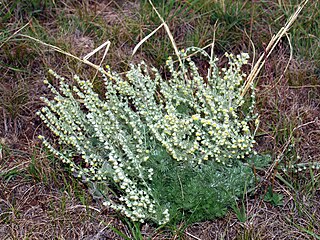
Artemisia frigida is a widespread species of flowering plant in the aster family, which is known as the sunflower family. It is native to Europe, Asia, and much of North America. In parts of the north-central and northeastern United States it is an introduced species.

Symphyotrichum oolentangiense, commonly known as skyblue aster and azure aster, is a species of flowering plant in the family Asteraceae native to eastern North America.

Petrorhagia saxifraga, known as tunic flower or coat flower, is a small, herbaceous flowering plant in the family Caryophyllaceae. It is native to parts of Europe and introduced to the United States and Canada, Great Britain, and Sweden. Petrorhagia saxifraga is also known as tunic saxifrage, pink saxifrage, or just pink.

Symphyotrichum racemosum is a species of flowering plant native to parts of the United States and introduced in Canada. It is known as smooth white oldfield aster and small white aster. It is a perennial, herbaceous plant in the family Asteraceae. It is a late-summer and fall blooming flower.



















